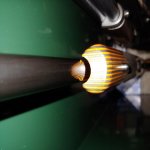- Location
- Steel Town and The Peg
I would like to have my 1991 M77 Tang Safety glass bedded into a Boyds stock. Anybody experienced with Rugers? Thanks
They are easy to bed.
There is a small flat ahead of the recoil lug and it is enough to allow the rifle to be bedded with the barrel fully floated. As on the Model 70, bedding at the center screw location is optional and complicates the procedure. I like to cast fiberglass pillars for the front and rear screws and just use a spacer for the center screw.
I am referring to the flat portion of the receiver which is ahead of the recoil lug and the screw. While not a large area, it is more than sufficient to allay any concerns about cantilevering. The Ruger can be bedded with the barrel fully floated and with clearance under and in front of the recoil lug. Ruger 77's respond very well to glass bedding.









































